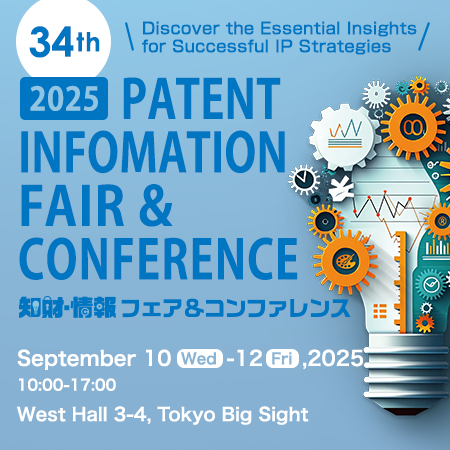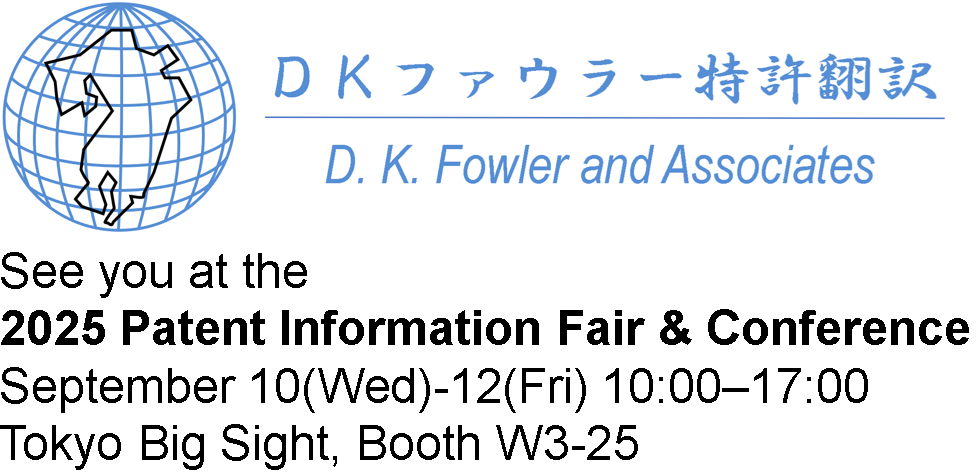
Upcoming Event:
Patent Translation: Japanese to English
Quality
Reliability
Efficiency
We are dedicated to consistently providing the highest possible quality with maximum efficiency.
Certificates of Accuracy provided upon request.
Here are some noteworthy developments and decisions related to patent translation and claim construction:
USPTO fees continue to increase. As of April 27, 2025:
・37CFR§1.17(e)(1) Request for Continued Examinations (RCE) place a higher burden on pre-application readiness. First RCE request will cost $1,500, with an additional $2,860 for each additional request.
・37CFR§1.16(j) Multiple dependent claim: $925
・37CFR§1.16(h) Each independent claim in excess of three: $600
・37CFR§1.16(i) Each claim in excess of 20: $200
EPO fees as of April 01, 2024:
・015 - Claims fee:
⇒ EUR 275 for the 16th and each subsequent claim up to 50,
⇒ EUR 685 for the 51st and each subsequent claim
・501 - Additional filing fee for the 36th and each subsequent page: EUR 17/page
The Chamberlain Group, Inc. v. Techtronic Industries Co. Ltd., CAFC (2019), N.D. IL (2017)
The Applicant (and subsequent Patent Owner) sought protection for a claim would encompass any garage door opener that can wirelessly transmit its status conditions. However, the technologies of garage door openers and wireless transmitters were already available in 2003, when the application was filed. The USPTO Examiner granted patent rights after four rejections and two Requests for Continued Examinations (RCE). The amended claim specified that the wireless signal must include (1) a device identifier, and (2) at least two operating states. An infringement suit ensued, and the District Court supported the validity of the asserted claim. The Federal Circuit, however, found the invention to be directed to the abstract idea of combining an off-the-shelf conventional wireless transmitter with the prior art, invoking 35 U.S.C. § 101 to invalidate the asserted claim.
Shrubbery from Jacksons Fencing, UK
“Crafted for Life, Made with Passion”

Chamberlain v. Techtronic, Federal Circuit 2019
Chamberlain v. Techtronic, Federal Circuit 2017 (for Markman)
Chamberlain v. Techtronic, N.D. IL 2018
Chamberlain v. Techtronic, N.D. IL 2017
Chamberlain v. Techtronic, N.D. IL 2017 (Markman)
USP 7224275
USP Application 10/447663 (excerpt)
American Axle & Manufacturing, Inc. v. Neapco Holdings LLC, CAFC (2019/2020), D.C. DE (2018)
An automotive drive shaft liner was invented to reduce vibrations across multiple vibration modes, as illustrated below. An example in the specification describes a 4-inch diameter/14-inch long liner (270 g mass) positioned symmetrically about the second bending node of a 4-inch diameter/64-inch long aluminum shaft (3.2 kg mass). Damping performance goals are recited for tuning (by any method) and positioning (by any method), and drawings illustrate various liner shapes (designed by any method). The accused infringer used the Alice framework to "one-oh-one" the asserted claims as patent-ineligible, and was granted summary judgement of noninfringement under 35 U.S.C. § 101. The Federal Circuit involved the natural law and abstract idea categories in the analysis, and continued the policy that a "goal without a solution" is ineligible.
USP 7,774,911


American Axle, Federal Circuit
American Axle, D.C. DE
USP 7774911
Stylwan IP Holding, LLC v. Stress Engineering Services, Inc., CAFC (2025), S.D. TX (2020)
This system was developed to non-destructively estimate the remaining life of pipes and many other materials used in industrial environments, thereby replacing inaccurate manual inspections with automated calculations based on equations using a database incorporating multidisciplinary expertise. The asserted claims, however, encompassed non-autonomous inspections and did not specify the equations to be used. The District Court found that the asserted patents were not directed to patent-ineligible matter under 35 U.S.C. § 101, and relied on intrinsic evidence and the enablement requirement under 35 U.S.C. § 112 to construe the claims to include the limitations of (1) autonomous processing, and (2) the use of three specific equations disclosed in an embodiment. The Federal Circuit supported the District Court's claim construction and its judgement of noninfringement.

Ariosa Diagnostics, Inc. v. Sequenom, Inc., CAFC (2015), N.D. CA (2012)
The inventors discovered that cell-free fetal DNA (“cffDNA”) is naturally present in maternal blood samples, making possible prenatal diagnosis of paternally-inherited fetal DNA without taking samples from the fetus or placenta. Before this discovery, researchers reportedly did not know such genetic material was present in maternal blood. A patent was awarded for methods including conventional detection techniques applied to this new use of maternal plasma, and potential infringers were challenged. However, the asserted claims were deemed ineligible under 35 U.S.C. § 101, with an emphasis on disallowing the preemption or monopoly of access to naturally occurring phenomena.

Ariosa v. Sequenom, Federal Circuit
Ariosa v. Sequenom, N.D. CA
USP 6258540
Ex parte Putre, PTAB (2008)
It would’ve been nice if all old tripods had a handle like the green one of the invention (below, right) to allow safe and stable carrying with one hand. The examiner and PTAB judge found this application unpatentable because the red knob (below, left) may be used similarly, even if the wrist is clamped and the fingers hurt. “While ... awkward, ... it does not appear to be impossible.”
Prior art: Dalton US 2,668,682 (1954) Application: PTAB Appeal 2008-1701 (2008)

Superguide Corporation v. DirecTV Enterprises, Inc., CAFC (2004), W.D. NC (2002)
This 1985 invention for a TV interactive program guide claimed “a program start time” and other items with the phrasing “at least one of A, B, C, and D”. Because the accused infringer's product presumably contained "A, B, and C" without including "D", Superguide asked for a Markush interpretation that would encompass “at least one of A, at least one of B, at least one of C, or at least one of D”. However, all four judges agreed that such a broad claim construction would render the patent invalid by including all conventional interactive guides. The only possible interpretation, then, was “at least one of A, at least one of B, at least one of C, and at least one of D”. Although this decision is based on the specific claimed elements rather than merely grammar, the uncertainty surrounding “at least one of A, B, C, and D” is often avoided by using Markush-type “consisting of” wording, phrases like “at least one of A, B, or C”, and other strategies.
Source: USP 5,038,211

In re Schreiber, CAFC (1997), PTAB (1996)
It seems like the know-how for making an easy-to-use popcorn funnel (below, right) would not be anticipated by a similar invention for oil (below, left), but this application was rejected under 35 U.S.C. § 102(b). Years later, a comparative study by the Trilateral Offices yielded various results, with the informal total being 7 judges for Not Anticipated, and 8 judges (plus 1 examiner) for Anticipated.
Prior art: Swiss No. 172,689 (1935) Application: PTAB (1996)

In re Schreiber, Federal Circuit
Trilateral Novelty Study: Hypothetical and Real Cases
Apple, Inc. v. Samsung Electronics Co., Ltd., CAFC (2012), N.D. CA (2012)
Be careful when using “each”. It can mean “every”, and it should be clear to the reader whether it means each of a particular set of items, or whether it encompasses each item in the entire apparatus. Here, “each” was intended to mean “each of a few modules in a cell phone”, but was deemed to encompass every module in the cell phone.
USP 8,086,604 (filed 2004)

Superior Fireplace v. Majestic Products Company, CAFC (2001), C.D. CA (2000)
Adding just one extra ‘s’ to a term could limit the claim scope to require multiple structures. Here, the defendants’ “Earth Stove” gas-powered fireplace had only one “rear wall”, thereby avoiding infringement.
rear wall ≠ rear walls
USP 5,678,534 (filed 1995)

Superior Fireplace v. Majestic Products, Federal Circuit
Superior Fireplace v. Majestic Products, C.D. CA
It would appear that a lot of great inventions fail to be recognized as novel contributions to life on earth.
It is our daily mission to provide translations and services that protect such inventions.
Specialized Interpreting
We provide specialized interpreting matched to our clients’ business goals, usually in the areas of R&D agreements, sales and promotion, and negotiations.
Contact Information
D. K. Fowler and Associates
7-13-303 Tsuchitorimachi, Tobata-ku Kitakyushu, Fukuoka 804-0014 JapanTelephone number: +81-93-981-9217
E-mail:
Payments accepted in US Dollars to our US bank, or in Japanese yen to our bank in Japan.
David Keen Fowler, Representative Member
David was born in Langdale, Alabama, and earned a Bachelors of Engineering in Mechanical Engineering at Vanderbilt University and a Masters of Engineering in Theoretical and Applied Mechanics at the University of Illinois Urbana-Champaign before joining a high-tech company serving the electronics and motor industries in Kitakyushu, Japan, where he worked for 14 years as an engineer.David has been translating patents for more than 17 years.


